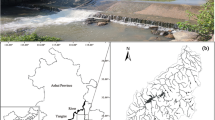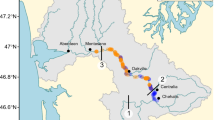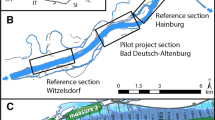Abstract
Corbicula fluminea is one of the most successful invasive species in neotropical freshwater ecosystems. As alien species’ distribution in invaded regions is often facilitated by the presence of anthropogenic altered ecosystems, such as artificial channels and reservoirs. The present study is part of a larger joint scientific assessment of the ecological effects of a run-of-river dam in the Pandeiros River Basin, Brazil, aiming at supporting decision making regarding its possible decommissioning. Our focus was to determine which in-stream physical habitat metrics are most important for the distribution of C. fluminea in Pandeiros river basin, a Neotropical dammed Savanna-river basin. We found that its occurrence was linked positively with sheltered margins and pipes in the riparian zone, and negatively with the distance from the Pandeiros River dam. These results show that C. fluminea distribution is closely linked to anthropogenic alterations in the physical habitat and, due to the dam influence in enhancing this invasive species distribution, we could recommend the decommissioning of the Pandeiros River dam, built in 1957, but whose economic activities, including electrical power generation, have been totally deactivated since 2007.

Similar content being viewed by others
Data availability
All data generated or analyzed during this study are included in this published article (and its supplementary information files).
References
Almeida EF, Oliveira RB, Mugnai R et al (2009) Effects of small dams on the benthic community of streams in an atlantic forest area of southeastern brazil. Int Rev Hydrobiol 94:179–193. https://doi.org/10.1002/iroh.200811113
Anderson D, Moggridge H, Warren P, Shucksmith J (2015) The impacts of ‘run-of-river’ hydropower on the physical and ecological condition of rivers. Water Environ J 29:268–276. https://doi.org/10.1111/wej.12101
Bartón K (2019) Package ‘MuMIn’. https://cran.r-project.org/web/packages/MuMIn/index.html
Böhm M, Dewhurst-Richman NI, Seddon M et al (2021) The conservation status of the world’s freshwater molluscs. Hydrobiologia 848:3231–3254. https://doi.org/10.1007/s10750-020-04385-w
Boltovskoy D, Karatayev A, Burlakova L et al (2009) Significant ecosystem-wide effects of the swiftly spreading invasive freshwater bivalve Limnoperna fortunei. Hydrobiologia 636:271–284. https://doi.org/10.1007/s10750-009-9956-9
Burnham KP, Anderson DR (2002) Model selection and multimodel inference: a practical information-theoretical approach. Springer-Verlag, New York
Callisto M, Macedo DR, Linares MS, Hughes RM (2019) Multistatus and multispatial scale assessment of landscape effects on benthic macroinvertebrates in the neotropical savanna. In: Hughes RM, Infante DM, Wang L, Chen K, Terra BF (eds) Advances in Understanding Landscape Influences on Freshwater Habitats and Biological Assemblages. American Fisheries Society Symposium, Bethesda, MD. https://doi.org/10.5281/zenodo.3519460
Cao L, Damborenea C, Penchaszadeh PE, Darrigran G (2017) Gonadal cycle of Corbicula fluminea (Bivalvia: Corbiculidae) in Pampean streams (Southern Neotropical Region). PLoS One 12:e0186850. https://doi.org/10.1371/journal.pone.0186850
Cataldo D, Boltovskoy D (1998) Population dynamics of Corbicula fluminea (Bivalvia) in the Paraná River Delta (Argentina). Hydrobiologia 380:153–163. https://doi.org/10.1023/A:1003428728693
Crespo D, Dolbeth M, Leston S et al (2015) Distribution of Corbicula fluminea (Müller, 1774) in the invaded range: a geographic approach with notes on species traits variability. Biol Invasions 17:2087–2101. https://doi.org/10.1007/s10530-015-0862-y
da Rosa LC, Dantas JO (2020) First record of the Asian clam Corbicula fluminea (Müller, 1774) (Bivalvia: Cyrenidae) at Poxim-Açu River, northeastern Brazil. Acta Limnol Bras 32:1–4. https://doi.org/10.1590/s2179-975x8019
Darrigran G (2002) Potential impact of filter-feeding invaders on temperate inland freshwater environments AN - prod.academic_MSTAR_1034829269; 17024049. Biol Invasions 4:145–156
Darrigran G, Agudo-Padrón I, Baez P et al (2020) Non-native mollusks throughout South America: emergent patterns in an understudied continent. Biol Invasions 22:853–871. https://doi.org/10.1007/s10530-019-02178-4
de Oliveira-Junior JMB, De Marco P, Dias-Silva K et al (2017) Effects of human disturbance and riparian conditions on Odonata (Insecta) assemblages in eastern Amazon basin streams. Limnologica 66:31–39. https://doi.org/10.1016/j.limno.2017.04.007
Dias E, Morais P, Antunes C, Hoffman JC (2014) Linking terrestrial and benthic estuarine ecosystems: organic matter sources supporting the high secondary production of a non-indigenous bivalve. Biol Invasions 16:2163–2179. https://doi.org/10.1007/s10530-014-0655-8
Doherty PF, White GC, Burnham KP (2012) Comparison of model building and selection strategies. J Ornithol 152:317–323
Dudgeon D, Arthington AH, Gessner MO et al (2006) Freshwater biodiversity: importance, threats, status and conservation challenges. Biol Rev 81:163. https://doi.org/10.1017/S1464793105006950
Fantin-Cruz I, Pedrollo O, Girard P et al (2016) Changes in river water quality caused by a diversion hydropower dam bordering the Pantanal floodplain. Hydrobiologia 768:223–238. https://doi.org/10.1007/s10750-015-2550-4
Fernandez MA, Thiengo SC, Simone LRL (2003) Distribution of the introduced freshwater snail Melanoides turbeculatuus (Gastropoda: Thiaridae) in Brazil. Nautilus (philadelphia) 117:78–82
Floury M, Delattre C, Ormerod SJ, Souchon Y (2012) Global versus local change effects on a large European river. Sci Total Environ 441:220–229. https://doi.org/10.1016/j.scitotenv.2012.09.051
Fonseca EMB, Grossi WR, Fiorini FA, Prado NJS (2008) PCH Pandeiros: Uma complexa interface com a gestão ambiental regional. In: VI simpósio Brasileiro sobre pequenas e médias centrais hidrelétricas. Minas Gerais, Belo Horizonte
Johnson PT, Olden JD, Vander Zanden MJ (2008) Dam invaders: impoundments facilitate biological invasions into freshwaters. Front Ecol Environ 6:357–363. https://doi.org/10.1890/070156
Karatayev AY, Padilla DK, Minchin D et al (2007) Changes in global economies and trade: the potential spread of exotic freshwater bivalves. Biol Invasions 9:161–180. https://doi.org/10.1007/s10530-006-9013-9
Kaufmann PR, Levine P, Robison EG, et al (1999a) Quantifying Physical Habitat in Wadeable Streams. EPA/620/R-99/003 US Environ Prot Agency, Washington, DC 130. doi: EPA/620/R-99/003
Kaufmann PRP, Levine P, Robison EEG, et al (1999b) Quantifying physical habitat in wadeable streams. EPA/620/R-99/003. U.S. Environmental Protection Agency, Washington, DC
Labaut Y, Macchi PA, Archuby FM, Darrigran G (2021) Homogenization of macroinvertebrate assemblages and Asiatic Clam Corbicula fluminea invasion in a river of the Arid Patagonian Plateau, Argentina. Front Environ Sci 9:1–13. https://doi.org/10.3389/fenvs.2021.728620
Leiva M, Marchese M, Diodato L (2020) Structure, distribution patterns and ecological responses to hydrological changes in benthic macroinvertebrate assemblages in a regulated semi-arid river: baseline for biomonitoring studies. Mar Freshw Res 72:200–212. https://doi.org/10.1071/MF19283
Lercari D, Bergamino L (2011) Impacts of two invasive mollusks, Rapana venosa (Gastropoda) and Corbicula fluminea (Bivalvia), on the food web structure of the Río de la Plata estuary and nearshore oceanic ecosystem. Biol Invasions 13:2053–2061. https://doi.org/10.1007/s10530-011-0023-x
Linares MS, Callisto M (2019) Pequena Central Hidrelétrica de Pandeiros e seu efeito sobre moluscos aquáticos invasores. MG Biota 12:78–89
Linares MS, Callisto M, Marques JC (2018) Thermodynamic based indicators illustrate how a run-of-river impoundment in neotropical savanna attracts invasive species and alters the benthic macroinvertebrate assemblages’ complexity. Ecol Indic 88:181–189. https://doi.org/10.1016/j.ecolind.2018.01.040
Linares MS, Assis W, Castro Solar RR et al (2019) Small hydropower dam alters the taxonomic composition of benthic macroinvertebrate assemblages in a neotropical river. River Res Appl. https://doi.org/10.1002/rra.3442
Linares MS, Callisto M, Marques JC (2020a) Assessing biological diversity and thermodynamic indicators in the dam decommissioning process. Ecol Indic 109:105832. https://doi.org/10.1016/j.ecolind.2019.105832
Linares MS, Macedo DR, Massara RL, Callisto M (2020b) Why are they here? Local variables explain the distribution of invasive mollusk species in neotropical hydropower reservoirs. Ecol Indic 117:106674. https://doi.org/10.1016/j.ecolind.2020.106674
Macedo DR, Hughes RM, Ligeiro R et al (2014) The relative influence of catchment and site variables on fish and macroinvertebrate richness in cerrado biome streams. Landsc Ecol 29:1001–1016. https://doi.org/10.1007/s10980-014-0036-9
Malmqvist B, Rundle S (2002) Threats to the running water ecosystems of the world. Environ Conserv 29:134–153. https://doi.org/10.1017/S0376892902000097
Martins I, Macedo DR, Hughes RM, Callisto M (2020) Are multiple multimetric indices effective for assessing ecological condition in tropical basins? Ecol Indic 110:105953. https://doi.org/10.1016/j.ecolind.2019.105953
Martins I, Castro DMP, Macedo DR et al (2021a) Anthropogenic impacts influence the functional traits of Chironomidae (Diptera) assemblages in a neotropical savanna river basin. Aquat Ecol 55:1081–1095. https://doi.org/10.1007/s10452-021-09884-z
Martins I, Macedo DR, Hughes RM, Callisto M (2021b) Major risks to aquatic biotic condition in a Neotropical Savanna River basin. River Res Appl 37:858–868. https://doi.org/10.1002/rra.3801
Mbaka JG, Wanjiru Mwaniki M (2015) A global review of the downstream effects of small impoundments on stream habitat conditions and macroinvertebrates. Environ Rev 23:257–262. https://doi.org/10.1139/er-2014-0080
Oliveira MD, Calheiros DF, Jacobi CM, Hamilton SK (2011) Abiotic factors controlling the establishment and abundance of the invasive golden mussel Limnoperna fortunei. Biol Invasions 13:717–729. https://doi.org/10.1007/s10530-010-9862-0
Olsen AR, Peck DV (2008) Survey design and extent estimates for the Wadeable Streams assessment. J North Am Benthol Soc 27:822–836. https://doi.org/10.1899/08-050.1
Ortega JCG, Júlio HF, Gomes LC, Agostinho AA (2015) Fish farming as the main driver of fish introductions in Neotropical reservoirs. Hydrobiologia 746:147–158. https://doi.org/10.1007/s10750-014-2025-z
Peck D, Herlihy A, Hill B, et al (2006) Environmental Monitoring and Assessment Program-Surface Waters Western Pilot Study: field operations manual for wadeable streams. EPA/620/R-06/003. U.S. Environmental Protection Agency, Washington, DC
Pérez-Quintero JC (2008) Revision of the distribution of Corbicula fluminea (Müller 1744) in the Iberian Peninsula. Aquat Invasions 3:355–358. https://doi.org/10.3391/ai.2008.3.3.13
Petsch DK (2016) Causes and consequences of biotic homogenization in freshwater ecosystems. Int Rev Hydrobiol 101:113–122
Reshaid Y, Cao L, Brea F et al (2017) Variation in the distribution of Corbicula species (Mollusca: Bivalvia: Corbiculidae) after 25 years of its introduction in the Río de la Plata, Argentina. Zoologia 34:1–6. https://doi.org/10.3897/zoologia.34.e22181
Santos U, Silva PC, Barros LC, Dergam JA (2015) Fish fauna of the Pandeiros River, a region of environmental protection for fish species in Minas Gerais state, Brazil. Check List. https://doi.org/10.15560/11.1.1507
Simberloff D, Martin J-L, Genovesi P et al (2013) Impacts of biological invasions: what’s what and the way forward. Trends Ecol Evol 28:58–66. https://doi.org/10.1016/j.tree.2012.07.013
Sousa R, Antunes C, Guilhermino L (2008) Ecology of the invasive Asian clam Corbicula fluminea (Müller, 1774) in aquatic ecosystems: an overview. Ann Limnol Int J Limnol 44:85–94. https://doi.org/10.1051/limn:2008017
Sousa R, Gutiérrez JL, Aldridge DC (2009) Non-indigenous invasive bivalves as ecosystem engineers. Biol Invasions 11:2367–2385. https://doi.org/10.1007/s10530-009-9422-7
Thomaz SM, Kovalenko KE, Havel JE, Kats LB (2015) Aquatic invasive species: general trends in the literature and introduction to the special issue. Hydrobiologia 746:1–12. https://doi.org/10.1007/s10750-014-2150-8
Wang H, Chen Y, Liu Z, Zhu D (2016) Effects of the “Run-of-River” hydro scheme on macroinvertebrate communities and habitat conditions in a Mountain River of Northeastern China. Water 8:31. https://doi.org/10.3390/w8010031
Zhan A, Zhang L, Xia Z et al (2015) Water diversions facilitate spread of non-native species. Biol Invasions 17:3073–3080. https://doi.org/10.1007/s10530-015-0940-1
Zipp KY, Lewis DJ, Provencher B, Vander ZMJ (2019) The spatial dynamics of the economic impacts of an aquatic invasive species: an empirical analysis. Land Econ 95:1–18. https://doi.org/10.3368/le.95.1.1
Acknowledgements
We are grateful for financial support from P&D Aneel-Cemig GT-599 and GT-611, the Fundação de Amparo à Pesquisa de Minas Gerais (FAPEMIG) through the APQ-01961-15 project and Coordenação de Aperfeiçoamento de Pessoal de Nível Superior (CAPES)—Finance Code 001. MSL received a postdoctoral scholarship from P&D Aneel-Cemig GT-599. MC was awarded CNPq research productivity grant 304060/2020-8 and FAPEMIG research grant PPM 00104-18. DRM was awarded CNPq research productivity grant 309763/2020-7. Carlos B. M. Alves provided logistical support. Isabela Martins provided support with field sampling and design. JCM was supported by the Portuguese FCT through the project UIDB/04292/2020–MARE-Marine and Environmental Sciences Centre. Colleagues from the Universidade Federal de Minas Gerais (UFMG) and Universidade Federal de Lavras (UFLA) helped with field sampling. Several colleagues from the Laboratório de Ecologia de Bentos ICB/UFMG helped with sample processing. This project was authorized by the Instituto Estadual de Florestas (IEF—057/2016) and Sistema de Autorização e Informação em Biodiversidade (SISBIO—10365-2).
Funding
This work was supported by Aneel-Cemig (P&D GT-599 and GT-611), Fundação de Amparo à Pesquisa de Minas Gerais (FAPEMIG; APQ-01961-15) and Coordenação de Aperfeiçoamento de Pessoal de Nível Superior (CAPES; Finance Code 001). Author MSL received a postdoctoral scholarship from P&D Aneel-Cemig GT-599. Author DRM was awarded CNPq research productivity grant 309763/2020-7. Author JCM was supported by the Portuguese FCT through the project UIDB/04292/2020–MARE-Marine and Environmental Sciences Centre. Author MC was awarded CNPq research productivity grant 304060/2020-8 and FAPEMIG research grant PPM 00104-18.
Author information
Authors and Affiliations
Contributions
All authors contributed to the study conception and design. Data collection and analysis were performed by Marden Seabra Linares and Diego Rodriges Macedo. The first draft of the manuscript was written by Marden Seabra Linares and all authors commented and contributed on previous versions of the manuscript. All authors read and approved the final manuscript.
Corresponding author
Ethics declarations
Conflict of interests
The authors have no relevant financial or non-financial interests to disclose.
Additional information
Publisher's Note
Springer Nature remains neutral with regard to jurisdictional claims in published maps and institutional affiliations.
Supplementary Information
Below is the link to the electronic supplementary material.
Rights and permissions
Springer Nature or its licensor holds exclusive rights to this article under a publishing agreement with the author(s) or other rightsholder(s); author self-archiving of the accepted manuscript version of this article is solely governed by the terms of such publishing agreement and applicable law.
About this article
Cite this article
Linares, M.S., Macedo, D.R., Marques, J.C. et al. Anthropogenically physically changed habitats enable an easier propagation of invasive bivalve in neotropical headwater streams. Biol Invasions 24, 3855–3863 (2022). https://doi.org/10.1007/s10530-022-02886-4
Received:
Accepted:
Published:
Issue Date:
DOI: https://doi.org/10.1007/s10530-022-02886-4




